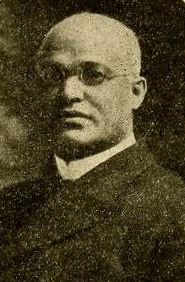Charles Spencer Smith facts for kids
Charles Spencer Smith (1852–1923) was an important leader in the African Methodist Episcopal Church (AME Church). He was a Methodist minister and later became a bishop, which is a high-ranking church official. He also served as a lawmaker in Alabama.
Charles Spencer Smith wrote many books and articles. One of his famous books, Glimpses of Africa, was about his trip to Africa in 1894. He also wrote a history of the AME Church.
Born in Canada, Smith moved to the United States when he was 14. After working different jobs and serving in the Alabama Legislature, he became a minister. He led churches in several southern states. Later, he helped create the AME Church's own Sunday School Union and a publishing house. As a bishop, he traveled widely, leading church meetings in many countries.
Contents
Early Life and Education
Growing Up in Canada
Charles Spencer Smith was born on March 16, 1852. His parents were Catherine and Nehemiah Henry Smith. He grew up in Bowmanville, Canada. He went to public school there until he was 12 years old.
He started learning to finish furniture. But his training ended when the factory he worked in burned down.
Moving to the United States
At age 14, Smith moved to Buffalo, New York. He worked as a general helper at a boarding house. In 1868, he moved to Chicago. There, he worked as a porter in a barber shop. He also worked as a deckhand on ships in the Great Lakes.
In 1869, Smith went to Louisville, Kentucky. He wanted to become a teacher. He applied for a job with the Freedmen's Bureau. This group helped formerly enslaved people after the Civil War.
Career and Church Leadership
Teaching and Politics
Smith's first teaching job was in Louisville. However, he faced threats from the Ku Klux Klan. So, he moved to teach in Hopkinsville, Kentucky. He then taught in Jackson, Mississippi. While there, he became a licensed minister in the AME Church. He continued teaching in other Mississippi towns.
In 1872, Smith began his first church mission in China Grove, Mississippi. The next year, he moved to Alabama. He became a pastor in Union Springs, Alabama. He also became active in politics. In 1874, he was elected to the Alabama House of Representatives. This was during the Reconstruction period. He served until 1876.
Family and Further Studies
In April 1876, Smith married Katie Josephine Black. They had three children, but only one, Susan Elnora, lived. Smith then decided to go back to school. He studied at Central Tennessee College and Meharry Medical College. He earned his medical degree in 1880. During his studies, he also served as a pastor in Pittsburgh, Pennsylvania.
Founding a Publishing House
After finishing medical school, Smith moved to Illinois. He worked for a Sunday School Publishing House. He was very impressed by their work. He suggested that the AME Church should have a similar organization.
In 1882, Smith founded the Sunday School Union of the AME Church. It was located in Nashville, Tennessee. He was its treasurer and secretary until 1900. He bought a building and set up a publishing house. This was the first steam printing business in the country owned by an African American.
The Union published two magazines. They were called The Child's Recorder and Our Sunday School Review. Smith edited both of them. His first wife, Katie, passed away in 1885. Three years later, in December 1888, Smith married Christine Shoecraft. She was a teacher from Indiana.
Becoming a Bishop
In 1900, Charles Spencer Smith became a bishop of the AME Church. This meant he was a senior leader. He was put in charge of church districts in Canada, the Caribbean, and South America. Later, he also oversaw districts in Louisiana.
In 1904, he was assigned to South Africa. Two years later, he went to West Africa. He also led church conferences in Georgia and Texas. In 1916, he was assigned to Canada, Bermuda, and Michigan. Smith traveled a lot. He visited many parts of the United States, the Caribbean, Europe, and Africa. He spoke at many church meetings.
In 1920, Smith retired from leading conferences. He was then appointed as the church's historian.
Later Life and Legacy
Charles Spencer Smith passed away on February 1, 1923. He died at his home in Detroit, Michigan. His personal papers and writings are kept at the Bentley Historical Library in Ann Arbor, Michigan. They cover the years from 1875 to 1923.


